|
||||
|
030719Singapore pet health and
welfare, educational for animal lovers, from
Asiahomes Internet Tips for Pet Lovers, sponsored by
AsiaHomes Internet.
August 14, 2003 The first Shih Tzu puppy would not be anaesthesized 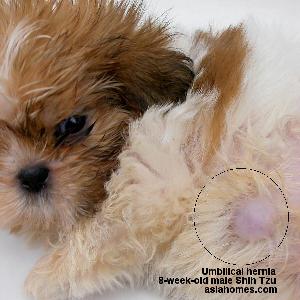 "Doc,
you forgot the surgery appointment of my Shih Tzu last week," Mr Wong, a
dog breeder reminded me. His 8-week-old Shih Tzu had a large belly button
in which two fingers could be inserted into. It was at least 6 cm in
diameter. "Doc,
you forgot the surgery appointment of my Shih Tzu last week," Mr Wong, a
dog breeder reminded me. His 8-week-old Shih Tzu had a large belly button
in which two fingers could be inserted into. It was at least 6 cm in
diameter. The intestinal loops could be seen under the thinned skin in this umbilical hernia which is a defect in the left and right abdominal muscle layers carrying the umbilical cord from the mother to puppy before birth. The puppy was still active but it had a poor appetite and had not put on as much weight as expected. I did not forget the appointment. Anaesthesia for a 2-month-old puppy is such a risky procedure that I hoped Mr Wong had forgotten about it as he had to go for his reservist training of 3 weeks soon. He was aware of the possibility of his puppy dying on the operating table. This was the first time he had asked me to perform surgery and I did not want to put my reputation on the line doing a risky one. I always recommend to breeders that umbilical hernias over 1 cm in diameter (one finger can be inserted into the hernia opening) should be closed up early as they tend to split open. The puppy feels the pain and eats less. It licks the swelling. It does not thrive usually as it gets pushed around by the stronger ones if housed in the same cage. Soon, it become stunted as the intestinal loops get incarcerated. When that happens, the puppy feels intense pain as the blood supply to the twisted intestines gets cut off. The tissues become gangrenous and the puppy dies despite emergency surgery. Now, what should I do? Umbilical hernia repair is a very simple surgery. The difficulty is to ensure that the puppy survives the anaesthesia during and after surgery. This puppy had not eaten much. His fluffy coat hid a thin frame. The surgery can't be delayed further. I brought the puppy back to the surgery after making sure that he had not eaten too much in the morning. Puppies cannot be starved 12 hours prior to surgery as they may become too weak and faint. He might vomit his food during anaesthesia and the vomitus might get into his lungs and cause pneumonia. His rectal temperature was 38.1 degrees Celsius. A bit low by 0.4 degrees. He looked weak. Rashes abounded on his chest as I shaved off the hair. I injected a very low dose of tranquiliser into his rump muscle. There was not much muscle. The tranquiliser was too low as he took a long time to sleep under gas anaesthesia. A small breathing tube was inserted into his lungs. The anaesthestic gas went into the lungs via the tube. His breathing was abnormal despite the fact that he was fully anaesthesized. His breathing was rapid as if he was panting away. There is a condition called malignant hyperthermia. The body temperature shoots up during anaesthesia and that will be very risky. Such rapid breathing would cause the body temperature to rise. Would the puppy then die from a high fever of malignant hyperthermia? The heart was pumping furiously. This was bad for the heart. I increased the gas a bit more but he was still breathing fast. He did not feel the pain of stitching. Only that he was not breathing slowly like normal puppies under surgical anaesthesia. The anesthesia gas did not stablise his breathing. The hernia was large. The tips of the maroon liver lobes appeared in the hole. The rib cage sternal bone was just a cm away and I could see the ribs now. The left and right abdominal muscles had slipped to the sides and I had to look for them to stitch them up. Would the puppy's heart stop suddenly as the rapid breathing must have stressed the heart. How fast could I stitch? It took time to find the muscle edges and its underlying peritoneum and then appose the two left and right sides. I had to be careful during stitching as the liver lobes were just below the opening. Time was of the essence in all puppy surgeries. If only this surgery was shorter like less than 1 minute. The puppy cried non-stop for ten minutes at the end of anaesthesia. He felt the pain. This was a most unusual case of anaesthesia as it seemed that he could not be fully anaesthesized. He was still drowsy. He had fluid therapy. I sent him back to the breeder's sister who was a very good and experienced puppy nurse. The breeder would care for him and feed him like her own children. This Shih Tzu was not looking for food unlike the others I operated on. He was weak. He was better the next day. 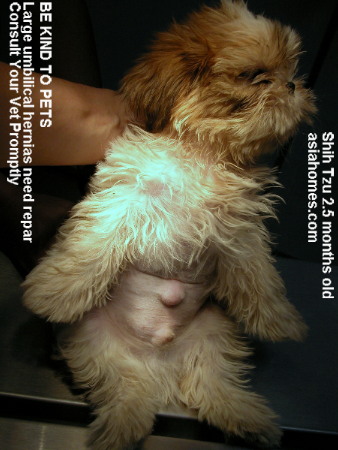 There was a 10-week-old Shih Tzu puppy with the same problem. He was
fatter and a better candidate for surgery. The herniated mass appeared smaller.
Simple surgery I thought. It would not take more than 3 minutes since the
anaesthesia was stable. The puppy was breathing slowly. I incise the loose
skin to stitch up.
There was a 10-week-old Shih Tzu puppy with the same problem. He was
fatter and a better candidate for surgery. The herniated mass appeared smaller.
Simple surgery I thought. It would not take more than 3 minutes since the
anaesthesia was stable. The puppy was breathing slowly. I incise the loose
skin to stitch up. To my surprise, the obvious defect was not solitary. There were two smaller ones towards the rib cage and given time, they would split open to coalesce with this bigger defect at the umbilicus. The stitching time was much longer. The puppy looked for food when he went back. Much depends on the nursing abilities of the breeder's sister now. The two puppies would not be bred. As I was busy, I did not follow up on the second day. On the fourth day after surgery, the second Shih Tzu had a large patch of iodine on her operated area as there was one stitch breakdown, leaking fluid from the abdominal area. "I let the two Shih Tzus stay in one cage as it is too lonely for each one to be individually caged," said the breeder. The puppies had licked each other's wound after taking out the bandage. The breeder applied iodine to the second Shih Tzu as the wound was seeping with fluid. The first one had just a last stitch licked off and the wound was dry. Despite the iodine, the Shih Tzu cleaned up the brown stain. "Bandage once more," I said. There were no further problems. The two Shih Tzus were eating well. No matter how pretty the white and gold colours are, I advised no further breeding from the two males as the condition can be inherited without the breeder being aware of it.
|

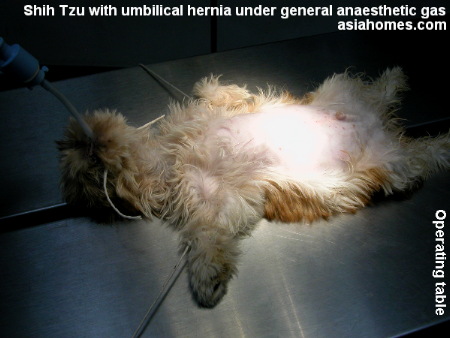
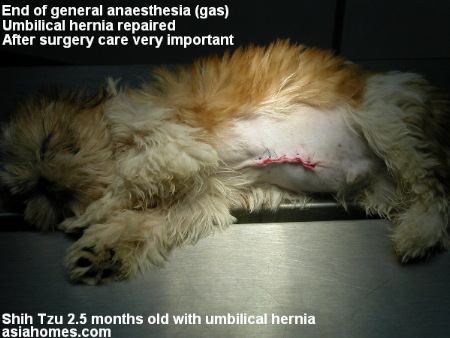
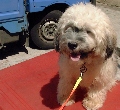 "He's a cross terrier," said the dog transport man with 15 years of experience
in handling dogs in Singapore. He must have seen all breeds and his authority cannot
be challenged.
"He's a cross terrier," said the dog transport man with 15 years of experience
in handling dogs in Singapore. He must have seen all breeds and his authority cannot
be challenged.